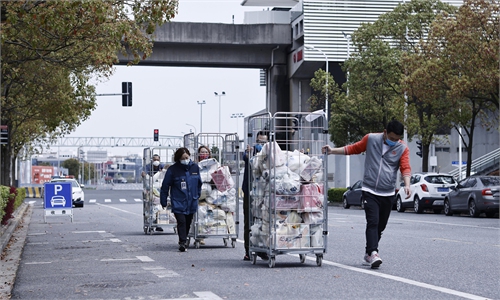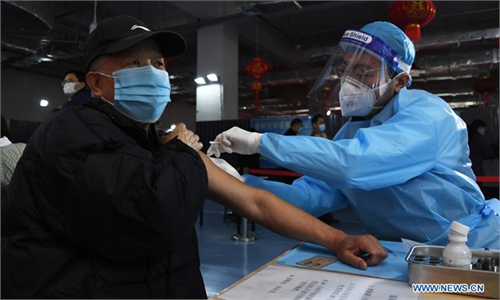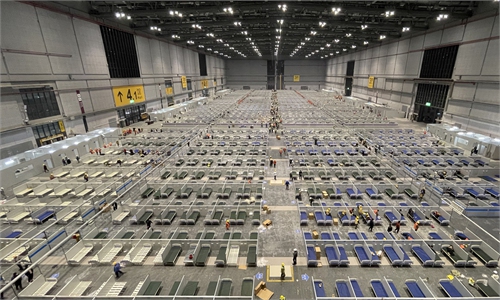
Shanghai streets are nearly deserted on April 19, 2022, as the megacity remains under strict epidemic control management except for the partial resumption in production of certain industries. Photo: VCG
Chinese officials have sought to dispel growing misconceptions and speculations about the country's dynamic zero-COVID strategy and reaffirmed their confidence in what has been widely considered to be the best strategy still to both contain the epidemic and ensure stable economic development, as the battle against the outbreak in Shanghai shows some positive signs and the city is at a crucial stage to bring community transmission down to zero.On the anti-epidemic front, the number of new COVID-19 cases registered on Monday declined by nearly 2,000 in Shanghai and more people are being discharged from designated or makeshift hospitals. Meanwhile, in the battle to resume economic activities, many companies in Shanghai and the broader Yangtze River Delta region are resuming operations, as officials have been rolling out a series of measures, including a "whitelist" of key businesses cleared for work resumption, to tackle logistics issues.
Since Friday, Shanghai has completed nucleic acid testing for 37 million people, and starting Tuesday, the city will continue testing in communities under control for three consecutive days, the local authority said on Tuesday. Screening out all the possible infections and adjusting the three categories of areas under different management aim to reach the goal of zero-COVID at the community level, laying the foundation for resuming normal life and production soon, according to the local authority.
There have been positive signs, such as the declining proportion of positive cases in at-risk groups, decreasing reproduction numbers and hundreds of local firms resuming production. A total of 23,286 people have been discharged from quarantine places, exceeding the number of people newly testing positive for the first time, the local authority said.
More firms including SAIC Motors and Tesla are resuming production.
Over 1,000 companies have already been continuing operations in closed loop since mid-March to keep the city functioning and to stabilize the supply chain.
"Considering the current prevention and control efforts, though daily cases are still surging, the reproduction numbers are dropping," Chen Xi, an associate professor of public health at Yale University, told the Global Times on Tuesday. Whether it could maintain a stable downward trend depends on the anti-epidemic measures the city adopts, like using antigen tests at home to avoid mass gatherings for nucleic acid tests, he said.
Vice Premier Sun Chunlan, who has been inspecting the anti-epidemic work in Shanghai, urged the local authorities on Monday to take decisive moves to clear all the infections at the community level by overcoming difficulties and strengthening confidence.
She told the media last week that the outbreak's reproduction numbers in Shanghai have dropped from 2.27 to 1.23 and "the goal of zero cases in the community is within reach."
Residential communities which haven't reported COVID-19 positive cases in the past 14 days could lift lockdowns gradually under a mechanism of daily nucleic acid tests for each resident, Lu Hongzhou, head of Shenzhen's anti-epidemic expert team and head of the Third People's Hospital of Shenzhen, told the Global Times on Tuesday.
In order to resume normal social life and prevent epidemic resurgence, frequent nucleic acid tests are needed, he said. For instance, all factory workers should receive daily nucleic acid tests and travel the same route between home and workplace every day, and avoid gatherings, Lu said, noting that public transportation should also open gradually.
The number of newly infected persons has been gradually dropping, Lu noted. "It's a key point to detect all the positive cases among communities with strict anti-epidemic measures. And the transmission will slow down once the transmission chain is cut off," he said.
Misunderstanding
However, some Western media and foreign organizations continued their biased narratives despite positive signs, saying that China's dynamic zero-COVID policy should be retreated and the city's lockdown tests the limits of the policy. Some also claimed that this policy is now facing more pushback from local residents and businesses in Shanghai as the costs of carrying it on began outweighing the benefits.
Top Chinese officials and senior epidemiologists refuted those claims, pointing out major misunderstandings about the country's dynamic zero-COVID policy. For example, dynamic zero-COVID does not mean having no infections or strict citywide lockdowns. Unlike some foreign enterprises and analysts who claimed that the policy would heavily affect economic growth, the policy has provided maximum protection to economic growth in the past two years, Wu Zunyou, chief epidemiologist of the Chinese Center for Disease Control and Prevention (CDC), said on Monday.
If the epidemic outbreak occurs at the early stage and is identified earlier, we only need to quarantine and treat patients and isolate close contacts to reach the dynamic zero-COVID target, Wu said. In the past two years, there have been 12 outbreaks in Shanghai but each had no more than 25 infections before they were put under control. "Only when we detect the outbreak late or could not take decisive measures to control it, leading to more transmissions in communities, do we have to put in place lockdown measures," he said.
If the epidemic outbreak becomes severe that we have to conduct mass nucleic acid testing and lockdown measures, the policy would have an impact on the economy, but the impact on the local GDP is only half of the impact of the non-dynamic zero-COVID strategy on the economy, Wu added, citing the preliminary mathematical analysis.
China was the first major economy to recover from the initial impact of COVID-19 in 2020 thanks to its swift and resolute response, and economic resilience continued throughout 2021 despite more pervasive strains wreaking havoc worldwide. In the first quarter of 2022, China achieved a GDP growth of 4.8 percent, official data showed on Monday, reflecting strong resilience.
Ma Xiaowei, director of the National Health Commission, said the country has entered the fourth stage of the anti-epidemic work, which requires the strictest, complete and decisive measures to cut off the transmission in communities in the face of the fast spreading Omicron.
"We're now fighting the Omicron up close. It's important to understand the variant throughout the fight, and to better understand our advantages and loopholes, which requires a more scientific and precise manner," Zeng Guang, former chief epidemiologist at the Chinese CDC, told the Global Times on Tuesday.
China's advantages
Since March, the Chinese mainland recorded over 490,000 domestically transmitted COVID-19 cases, affecting all the provinces except Southwest China's Xizang Autonomous Region, a health official said at a press conference on Tuesday. Wu also warned that we should be prepared for a long battle against the virus rather than being misled by claims such as "the epidemic will end this year."
"The fourth stage of the anti-epidemic work could be the most challenging," Chen said. "Take the example of Shanghai. When it faces Omicron, characterized by fast spread and a large number of asymptomatic cases, some of its previous measures did not work effectively, pointing to shortcomings also shared by some other cities and regions in China.
Fast cross-regional assistance and collective coordination of resources are widely seen as major advantages in China's anti-epidemic work, which have also proven effective in Shanghai's battle against Omicron. As of April 12, over 40,000 medical staff from 16 provinces have been dispatched to support the anti-epidemic work in Shanghai.
We have not identified the route of the virus mutation, but no matter how it mutates, we have to prepare for the worst, Wu said, noting the urgent tasks such as accelerating inoculation among elderly people and encouraging rapid antigen testing.
Other preparations include enhancing the isolation capacity as Omicron can cause a large amount of infections in a very short period, increasing the demand for anti-epidemic resources, which also highlights the shortage of quarantine places and Fangcang hospitals, according to experts and officials.
"The advantages of the system play out. To handle the infectious disease, we need to coordinate and cooperate," Chen said.




